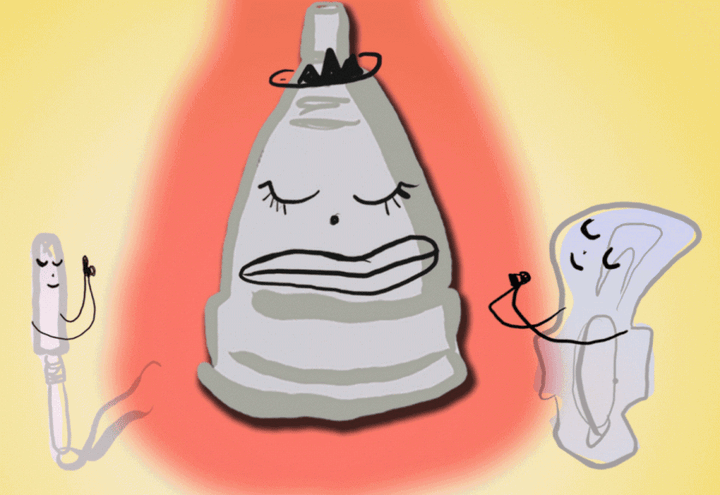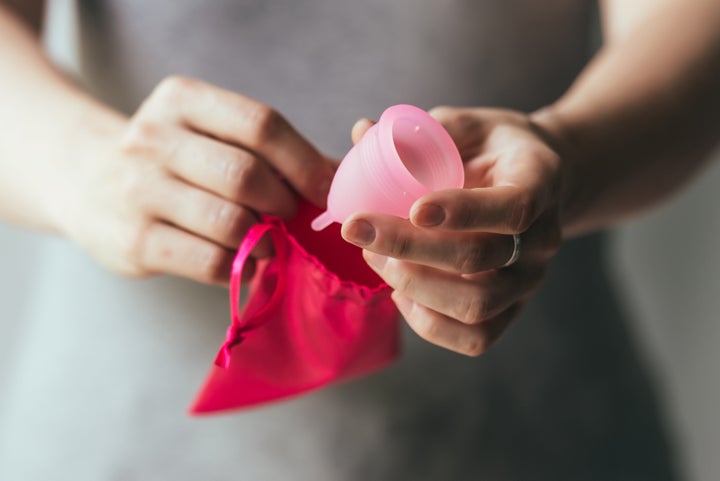
While I’d love to be the kind of eco-conscious wonder-feminist who you’d expect to waltz around in Toms, weaving my own reusable kitchen towels, and menstruating freely into a reusable silicone cup during my period, that’s just not me. I wear cheap Forever 21 kicks. I buy Bounty paper towels by the multi-roll pack. As an earth mother, I’m a failure.
That menstrual cup though? That’s my jam.
(Grandma, if you’re reading this, now is a great moment to check out one of my other articles instead of reading this one. Love you!)
I’ve been blissfully bleeding into a Diva Cup, a popular brand, for a couple years now (NB: only when it’s my time of the month -- don’t call 911). At times, my relationship with my cup has been contentious, even chilly, but I’ve come through to the other side, and I’m here to say: My Diva Cup is not a diva, but a queen of lady-blood-holding.
Sadly, you won’t see Diva Cups or its competitors on sale at the local Walgreens. Perhaps you’d stumble onto it at an organic food and wellness store. Or, perhaps, you’d hear about it on the kind of Internet forum where women gossip excitedly about being able to keep track of how much blood they’re producing each day due to the cup’s convenient design or how much they love to have period sex on red satin sheets and rejoice in their womanhood. (As much as I admire these women, I remain personally uninterested in measuring my period blood or spreading it on red satin sheets.)
Crunchy, alternative, with a soupçon of quackery: this is the menstrual cup’s cultural brand.
Not being into any of these things, what with my supermarket strawberries and generic Nyquil, I initially struggled with whether to invest in a Diva Cup. I hadn’t even learned how to use tampons until well into high school; intimate, gritty encounters with my bloody vaginal canal had never been on my bucket list.
And yet … I still hated tampons, the way they made me feel bloated and the constant rush to change them in public bathrooms, not to mention the expensive re-upping every month. The promise of a one-time investment followed by freedom from last-minute drugstore runs and, even better, the ability to only change the cup once every 12 hours, proved too strong a temptation.
When I bought my first Diva Cup, I was still in college, money-conscious and a bit idealistic. And I had no idea what was going on with my downstairs mix-up. To be totally clear, I had never had intercourse. So, perhaps unsurprisingly, when I tried to shove a folded wad of silicone into my untested lady bits, they were having none of it. Just adding water, a tactic I saw recommended online, did not help. Once or twice I was able to jam the bell-shaped cup inside, but the pain and protruding knob alerted me that I hadn’t found the knack. Finally, deeply disappointed in myself, the Diva Cup, and the entire feminine hygiene industry, I put the cup away and went back to my slim-fit tampons.

After several years, a college graduation, a big move to NYC, and some evolutions in my dating life I finally revisited the cup, tucked away in a now-linty purple pouch. When I was 24, I found myself in a steady relationship for the first time in a long time -- this time with a sexual intercourse component. “Maybe,” I thought, “I could fit my Diva Cup up there now, too!”
Who knows whether it was simply a few more years of maturity, the advent of sex, or the opportunity it brought to become more comfortable with my body -- perhaps even all of the above: The point is, the second time around, the cup fit. It still resisted easy insertion at first, or stubbornly refused to open fully once inside; occasionally I’d have leaks due to off-kilter placement. But I was so close to Diva Cup success, I could taste it. Especially after disinfecting the cup by boiling it in the one cooking pot I owned. (I scrubbed it so thoroughly afterward, really.)
I kept trying. No big deal, but I’m basically a pro at it now. I can even use it in a public or workplace bathroom -- although, and this is the joy of the Diva Cup, I never really have to. I can just replace it after I get home and before I leave for work. It’s the 12-hour wonder. And for those who might ask, what if you leave it in for a couple hours too long and it just starts overflowing? That does not happen. As a normal-level bleeder, I have yet to come close to filling the cup during a 12-hour, er, period.
What else do I love about my Diva Cup? I never, ever worry about it leaking profusely as long as I’ve placed it correctly. I never worry about leaving it in an extra few hours and getting Toxic Shock Syndrome (maybe just a paranoia, but one I still hold). I don’t get that icky period blood odor, which only develops when you have congealed blood exposed to air on your person. I am never out of tampons at a crucial moment. Oh, and I paid $40 for it at some point, but it’s paid for itself many times over.
What don’t I love about it? When a friend quietly asks me if she can bum a tampon, I usually can’t help her. Sorry, ladies, I really do wish I could help. Plus, I do wear pantiliners on my lowest-flow days or as back-up, so yeah, I’m still buying from Big Lady Pad and throwing the remnants into the trash.
Fortunately, that second problem may soon be a thing of the past. Thinx, a start-up by and for women, now offers cute, unobtrusive panties that actually soak up all of that menstrual blood without leaving you feeling wet or bulky. Reviews have suggested you can even free-flow in them, if you’re feeling risky, but to me it sounds like an ideal replacement for a limp liner loosely adhered to my least favorite pair of undies. (For every pair purchased, they send funding to AFRIpads to supply feminine hygiene products to women in Uganda. Double win.)
If I, a repressed, squeamish, Catholic-schooled woman who sometimes shops for groceries at CVS, can make the Diva Cup work for me, clearly it has mass appeal. Why does it seem to be stuck in a niche, marketed toward women who frequent moon goddess web forums and stores that specialize in organic herb supplements?

The oddball, hippie image of the cup seems to spring, in part, from the idea that no woman would want to deal with the misery of putting her fingers in her vagina unless she were willing to sacrifice all personal comfort to the cause of reducing waste and saving the environment. You’ll see this sentiment in anti-cup rants here and there: “I sheepishly ignore my normally eco-sensitive conscience and heed the wisdom of a friend who said, ‘Your period is not the time to save the Earth’ … Which is why I’m so confused about women who swear by the DivaCup,” wrote one woman. “My backup pads and wet wipes weren't exactly saving the landfills,” sniffed another after she tried.
But the cup is so much more than that! Sometimes I don’t bother sorting my recycling because my apartment is too small to conveniently set up a recycling bin AND a trash can. That’s the level of dedication I offer to the environment. Yet the Diva Cup won me over. Game, set, match. Let’s mainstream this product. When will the drug store shelves be lined with scented cups for those insecure about their odor, and pink floral ones for style-conscious menstruators?
It turns out, thankfully, we’re already on our way. Earlier this year, Rosemary Counter argued in MacLean’s magazine that the Diva Cup was actually a smart step on the path toward commercializing the reusable cup for a mainstream consumer base -- it’s translucent, unlike the mud-colored earlier offerings such as the Keeper, and comes in the aforementioned bright pouch.
Although you probably won’t stumble onto it at Walgreens, you might spot it at Whole Foods. (You can order it online at Walgreens if you really want to get it there for some reason.) In Canada, most major drug store chains carry the Diva Cup.
Counter also pointed to the Lily Cup Compact, a bright pink cup launched via a highly successful Kickstarter this year. Intimina, the Swedish company behind the product, has a far from crunchy image; they sell sleek, pink products for women ranging from “pelvic floor strengtheners” to “personal massagers.” If you know what they mean.
Still, we never see TV commercials in which a smiling brunette in khakis brandishes a silicone cup dripping with bright blue fluid at us. Worse, most chain stores in the U.S. don’t stock any brand of reusable menstrual cup. Kaitlin Ball, brand director at Softcup, told Racked, "We want to be an option that’s as easy as buying a tampon or a pad"; the cup isn’t close to there yet. Seeing these products on the shelves at Walmart and Rite Aid could go a long way toward normalizing their brand among American women, but the image of the caftan-clad, herb-munching hippie may also affect stores’ decisions to put menstrual cups on the shelves. “They’ll find it different, uncomfortable,” Sophie Zivku of Diva Cup told Racked. Business people aren’t immune to what she calls “the ick factor.”
So gather round me, women of the United States. If you don’t use Tom’s of Maine toothpaste, or buy only organic granola, or brew homeopathic teas instead of going to the doctor, a menstrual cup could still be right for you. It’s past time to fully mainstream this cost-conscious, eco-friendly, convenient way for women to manage their monthly blood-letting.
Now, to be clear, the Diva Cup isn’t for everyone. Some people will prefer the MeLuna, or the Lunette. But seriously, some people will always prefer tampons or pads, and I get that. I still use paper towels instead of homespun, reuseable cotton cloths. No individual woman should feel pressured to use a menstrual cup against her will.
As for me, though, I adore my Diva Cup, even though it gave me hell the first few months I tried to use it. It wasn’t always easy. Sometimes I felt like a crazy person as I hovered over a public toilet with a bloody, slippery cup clutched in my hands and my pants around my ankles. But I don’t regret a single second. Call me a dreamer, but I want more women like me -- basic, un-crunchy, drug-store shoppers -- to have that same beautiful journey.
Also on HuffPost:

